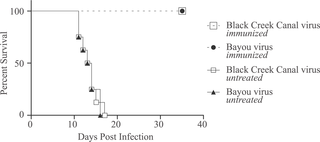PLOS Neglected Tropical Diseases ( IF 3.4 ) Pub Date : 2017-10-27 , DOI: 10.1371/journal.pntd.0006042 Valentijn Vergote 1 , Lies Laenen 1 , Bert Vanmechelen 1 , Marc Van Ranst 1 , Erik Verbeken 2 , Jay W Hooper 3 , Piet Maes 1

|
Background
Hantavirus, the hemorrhagic causative agent of two clinical diseases, is found worldwide with variation in severity, incidence and mortality. The most lethal hantaviruses are found on the American continent where the most prevalent viruses like Andes virus and Sin Nombre virus are known to cause hantavirus pulmonary syndrome. New World hantavirus infection of immunocompetent hamsters results in an asymptomatic infection except for Andes virus and Maporal virus; the only hantaviruses causing a lethal disease in immunocompetent Syrian hamsters mimicking hantavirus pulmonary syndrome in humans.
Methodology/Principal findings
Hamsters, immunosuppressed with dexamethasone and cyclophosphamide, were infected intramuscularly with different New World hantavirus strains (Bayou virus, Black Creek Canal virus, Caño Delgadito virus, Choclo virus, Laguna Negra virus, and Maporal virus). In the present study, we show that immunosuppression of hamsters followed by infection with a New World hantavirus results in an acute disease that precisely mimics both hantavirus disease in humans and Andes virus infection of hamsters.
Conclusions/ Significance
Infected hamsters showed specific clinical signs of disease and moreover, histological analysis of lung tissue showed signs of pulmonary edema and inflammation within alveolar septa. In this study, we were able to infect immunosuppressed hamsters with different New World hantaviruses reaching a lethal outcome with signs of disease mimicking human disease.
中文翻译:

使用免疫抑制叙利亚仓鼠的新世界汉坦病毒致命疾病模型。
背景
汉坦病毒是两种临床疾病的出血性病原体,在世界范围内发现其严重程度、发病率和死亡率各不相同。最致命的汉坦病毒出现在美洲大陆,那里最流行的病毒如安第斯病毒和辛诺布尔病毒已知会导致汉坦病毒肺综合征。免疫功能正常的仓鼠感染新世界汉坦病毒导致除安第斯病毒和马波拉病毒外无症状感染;在模仿人类汉坦病毒肺综合征的免疫功能正常的叙利亚仓鼠中唯一引起致命疾病的汉坦病毒。
方法论/主要发现
用地塞米松和环磷酰胺进行免疫抑制的仓鼠肌肉内感染了不同的新世界汉坦病毒株(河口病毒、黑溪运河病毒、德尔加迪托河病毒、乔克洛病毒、拉古纳内格拉病毒和马波拉病毒)。在本研究中,我们表明,在感染新世界汉坦病毒后对仓鼠进行免疫抑制会导致一种急性疾病,这种疾病与人类汉坦病毒病和仓鼠的安第斯病毒感染都非常相似。
结论/意义
受感染的仓鼠表现出特定的疾病临床症状,此外,肺组织的组织学分析显示肺泡间隔内有肺水肿和炎症的迹象。在这项研究中,我们能够用不同的新世界汉坦病毒感染免疫抑制的仓鼠,从而达到致命的结果,并出现类似人类疾病的疾病迹象。











































 京公网安备 11010802027423号
京公网安备 11010802027423号